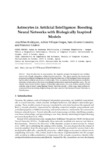Astrocytes in Artificial Intelligence: Boosting Neural Networks with Biologically Inspired Models
Title
Astrocytes in Artificial Intelligence: Boosting Neural Networks with Biologically Inspired ModelsDate
2024Abstract
Since its discovery in neuroscience, the tripartite synapse has inspired new architectures in the already ubiquitous artificial neural networks. This paper explains the frameworks proposed in artificial intelligence derived from the behaviour of the biological brain incorporating the called artificial astrocytes or artificial glia. First, we analyze the first structures on shallow networks, to later discuss the more convoluted configurations used in the past few years. We can classify them based on their degree of brain-like appearance, for some authors modeled them with this idea in mind (using Spiking Neural Networks mostly), while some other authors incorporated them in existing deep learning networks, such as Convolutional Neural Networks or Transformers.
Keywords
Neurons
Brain
Recurrent Neural Networks (RNNs)
Multilayer Perceptrons (MLPs)
Neuroscience
Synapse
Brain
Recurrent Neural Networks (RNNs)
Multilayer Perceptrons (MLPs)
Neuroscience
Synapse
Editor version
Rights
Atribución 3.0 España







